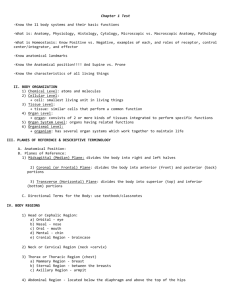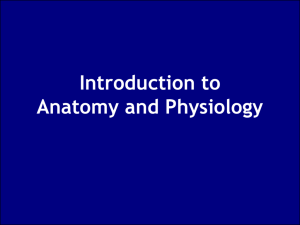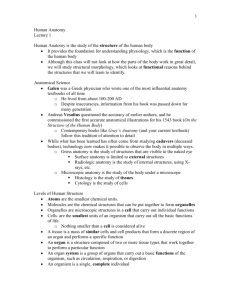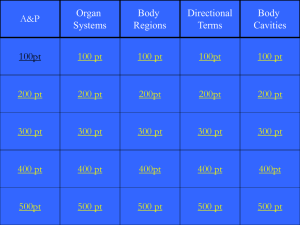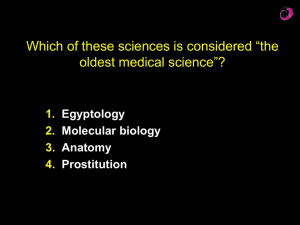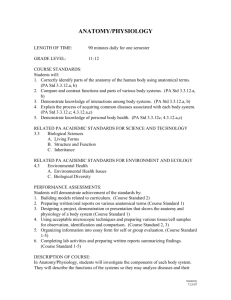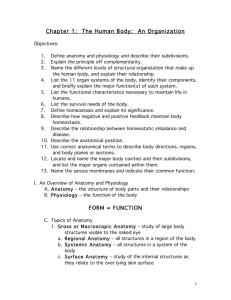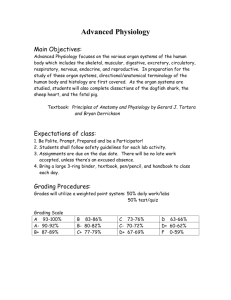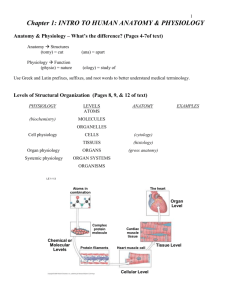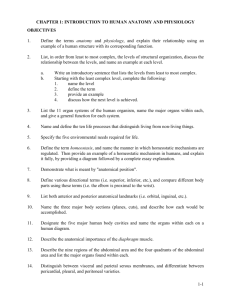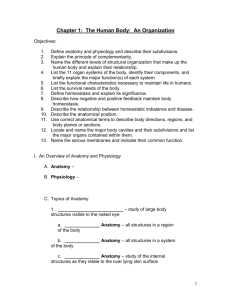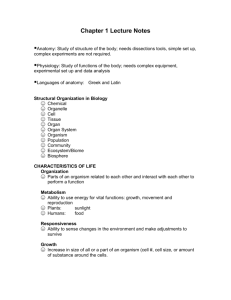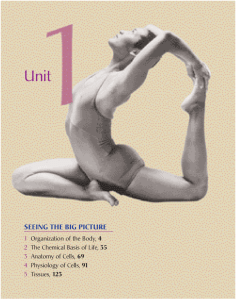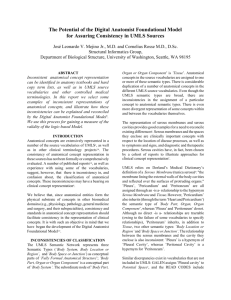File - mrsolson.com
advertisement
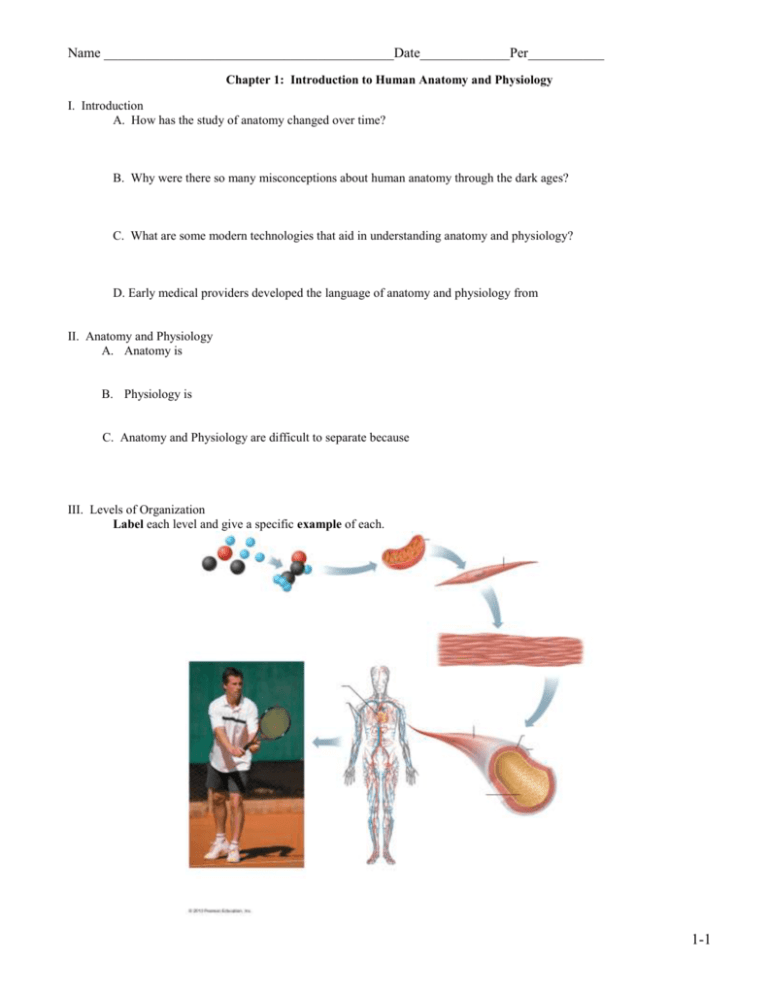
Name __________________________________________Date_____________Per___________ Chapter 1: Introduction to Human Anatomy and Physiology I. Introduction A. How has the study of anatomy changed over time? B. Why were there so many misconceptions about human anatomy through the dark ages? C. What are some modern technologies that aid in understanding anatomy and physiology? D. Early medical providers developed the language of anatomy and physiology from II. Anatomy and Physiology A. Anatomy is B. Physiology is C. Anatomy and Physiology are difficult to separate because III. Levels of Organization Label each level and give a specific example of each. 1-1 IV. Characteristics of Life A. Movement is B. Responsiveness is C. Growth is D. Reproduction is E. Digestion is F. Excretion is G. Metabolism is V. Maintenance of Life / Survival Needs A. Requirements of Organisms 1. The five requirements of life are ______________________, _________________________________, ___________________, ______________________________________, and _____________________ 2. The most abundant substance in the body is 3. Four major uses of water by the body are 4. Substances that provide organisms with nutrients are called 5. Nutrients supply 6. One-fifth (20%) of air is____________ which the body uses to __________________________________ 7. The form of energy used by the body is________ which helps maintain normal body temperature. 8. The application of force on an object is 9. What role does pressure play in our bodies? B. Homeostasis 1. Homeostasis is 2. Homeostatic mechanisms are 3. The three components of a homeostatic mechanism are 4. Receptors are 5. Control centers (set point) determine 6. Effectors provide 7. What is a negative feedback loop? 8. What is an example of a positive feedback loop? VI. The Human Body: an Orientation A. Relative Position 1. The position of the body in the anatomical position is 1-2 2. Label the right and left of the patient to the right. 3. The anatomical term meaning above another body part is 4. The anatomical term meaning below another body part is 5. The two anatomical terms meaning toward the front are __________________and_______________ 6. The two anatomical terms meaning toward the back are __________________and_______________ 7. The anatomical term meaning closer to the midline of the body is 8. The anatomical term meaning closer to the sides of the body is 9. The anatomical term meaning closer to a specific point is 10. The anatomical term meaning farther away from a specific point is 11. The two anatomical terms meaning closer to the surface of the body are____________and____________ 12. The anatomical term meaning more internal is B. Body Sections/Planes 1. Fill in the table Plane Also Known As Division Divides the body into left and right parts Divides the body into anterior and posterior (front and back) parts Divides the body into superior and inferior (upper and lower) parts 2. A cut across a cylindrical organ is called Longitudinal 3. An angular cut of a cylindrical organ is called 4. A lengthwise cut of a cylindrical organ is called VII. Organization of the Human Body A. Body Cavities / Regional Terms 1. The human body can be divided into an_________________ portion and an_______________________________portion. 2. The axial portion includes Cross section Oblique 3. The appendicular portion includes 4. The cranial cavity houses 5. The vertebral canal houses 6. The thoracic cavity is divided from the abdominopelvic cavity by the 7. The thoracic cavity contains the following organs: 8. The region between the lungs is the 1-3 9. Organs located in the mediastinum are 10. The two portions of the abdominopelvic cavity are 11. The organs of the abdominal cavity are 12. Organs of the pelvic cavity are 13. The other types of body cavities include: 14. Label the dorsal and ventral cavities and their subdivisions B. Thoracic and Abdominopelvic Membranes 1. Serous membranes 2. The serous membrane that covers the lungs is the 3. The serous membrane that covers the heart’s surface is the 4. What is the purpose of the serous fluid? 5. The serous membrane that lines the abdominopelvic wall is the C. Organ Systems: See organ system packet! D. Body Regions 1. Label the nine abdominal regions on the diagram below: 2. Label the four quadrants of the abdomen on the diagram below: 1-4 E. Give the correct anatomical term for the following body regions: region between thorax and pelvis __________________________ point of the shoulder ____________________________________ lower back between ribs and pelvis _________________________ forearm_______________________________________________ breast ________________________________________________ space in front of the elbow ________________________________ chin _________________________________________________ armpit ________________________________________________ nose _________________________________________________ arm __________________________________________________ lower posterior region of head _____________________________ cheek* _______________________________________________ mouth ________________________________________________ wrist _________________________________________________ eye cavity _____________________________________________ abdomen______________________________________________ ear __________________________________________________ head _________________________________________________ palm of hand __________________________________________ neck _________________________________________________ front of knee ___________________________________________ ribs* _________________________________________________ chest* ________________________________________________ hip __________________________________________________ foot __________________________________________________ leg __________________________________________________ pelvis* _______________________________________________ elbow* _______________________________________________ region between anus and external reproductive organs ______________________________ finger ________________________________________________ sole of the foot _________________________________________ back* ________________________________________________ area behind the knee ____________________________________ thigh _________________________________________________ posterior region between the hipbones ______________________ forehead ______________________________________________ middle and anterior region of thorax ________________________ reproductive organs _____________________________________ instep of foot __________________________________________ buttocks ______________________________________________ navel_________________________________________________ depressed area of the abdominal wall near the thigh ______________________________________ spinal column __________________________________________ 1-1


